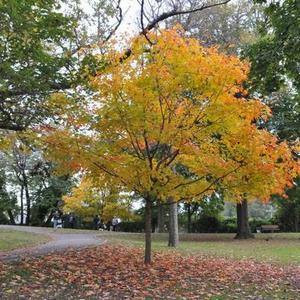
places_parks_playgrounds_300x300
Place Category: Parks and Playgrounds
Kissena Park, bounded by Oak Avenue, Hemstead Turnpike, Kissena Boulevard, and Fresh Meadow Lane, was acquired by the City of New York in pieces. In 1904, the City purchased Kissena Lake from William T. Janes, whose father-in-law had run an ice cutting and manufacturing company on the lake in the late 19th century. Following the death of horticulturist Samuel Bowne Parsons in 1906, the city acquired his historic tree grove, and a year later 65 acres of what was then mostly swampland were purchased. In 1914 the city bought a training farm for the Police Department’s horses. Condemnation procedures and private purchases added to the park through 1927, and in 1947 Kissena Park became part of the “Queens Corridor” park system through the addition of Kissena Corridor Park, which links Kissena Park with Flushing Meadows-Corona Park and Cunningham Park.
The park was named by its developers in 1908 after Kissena Lake. It is thought that Parsons, an amateur Indian expert, named the lake in the mid-19th century after the Chippewa word “kissina,” meaning “it is cold.” The Chippewa are a Midwestern tribe, native to Baraga County, Michigan.
Throughout most of the 18th and 19th century, Flushing enjoyed the reputation of America’s premiere horticultural center. William Prince established the New World’s first commercial nursery in Flushing 1735. Famous patrons of the area’s plants and trees included England’s future King William IV, George Washington, and explorers Meriwether Lewis and William Clark, who left behind specimens from their expeditions.
In the early 1870s Parsons started his own nursery at the site now home to the historic tree grove. Parson’s nursery imported over 100 varieties of exotic trees, and was the first nursery to introduce Japanese maples and propagate rhododendron. Urban park planner Frederick Olmsted purchased and used many of Parson’s trees for the construction of Central Park and Brooklyn’s Prospect Park. Now more than 100 different types of trees can be found in Kissena Park, including Iranian parrotia and cork, Chinese toon, Asian katsura, and the rare bald cypress.
Since 1907 Kissena Park has undergone many improvements and renovations. In 1942, Kissena Lake was transformed into a “bathtub lake” when the Works Progress Administration drained it, built an encompassing stone retainer, and refilled it. The lake had to be drained again in 1983 due to a buildup of algae. Today the lake is home to a wide variety of plant and animal life, including snapping turtles, ducks, herons, egrets, and gallinules.
The Siegfried Stern Kissena Park Bicycle Track, New York City’s only public bike track, was built in 1963. The track was named for Siegfried Stern, treasurer for Hartz Mountain Products and benefactor of many Jewish organizations. An annual junior cycling race, sanctioned by the Amateur Bicycle League of America, was founded in his honor when the track was named. In September 1964 the track was the scene of the United States Olympic Team trials. In addition to the bike track the park also features tennis and handball courts and a golf course.
In 1981 a group of park interns revitalized the historic tree grove by cleaning it, identifying its trees, and creating informative brochures about the site. Community groups such as the Kissena Park Civic Association take active roles in preventing over-development, initiating park clean-ups, planting gardens, and installing litter basins.
The Charlie Emerson Wildlife Garden and adjacent nature center was dedicated to the memory of naturalist and Queens resident Charlie Emerson in 1990. The garden was first planted in 1986 and contains Autumn olive, katsura, raspberry, and mulberry bushes, along with Queen Anne’s lace, evening primrose, wild grape, and milkweed.
- Flushing
Queens
New York
11355
United States No Records Found
Sorry, no records were found. Please adjust your search criteria and try again.
Google Map Not Loaded
Sorry, unable to load Google Maps API.
-

